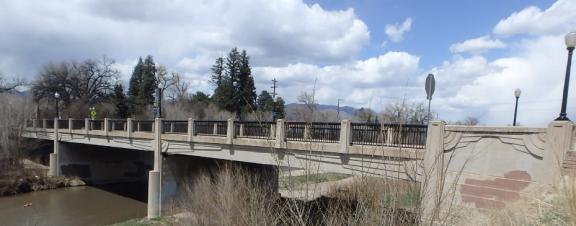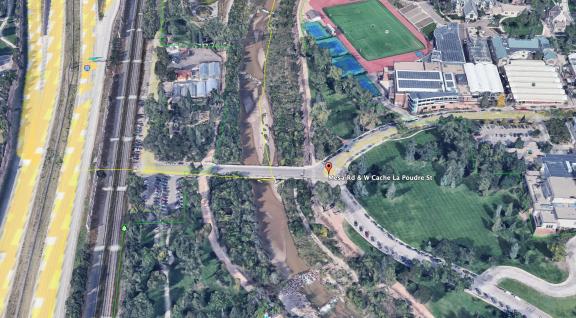
The City of Colorado Springs is currently designing a rehabilitation of the Cache La Poudre / Mesa Road Bridge over Monument Creek. The bridge is located in Monument Valley Park, between Glen Avenue and Mesa Road, adjacent to the Historic Uptown Neighborhood and Colorado College.
The City previously performed maintenance efforts to patch the existing concrete bridge deck and adjacent sidewalks, but the current condition requires a full rehabilitation and a longer-term fix to ensure the bridge remains safe and usable.
The rehabilitation work will include a deck replacement, roadway and drainage improvements, bridge lighting, updated accessibility features and architectural treatments.
Construction Impacts
The 80-year-old City bridge is used by vehicle, bicycle and pedestrian traffic, trail users, and park and pool users/pickleball players. The bridge will fully close to all forms of traffic during construction with a trail and vehicular detours in place. Vehicles, bicycles and pedestrians will not be able to cross the bridge during construction.
North and south trail continuity will be maintained during construction; however, the new trail under the bridge’s east connection will need to be temporarily closed during construction for safety reasons due to overhead construction.
Works Projects Administration (WPA) rock walls constructed in the 1930’s on the east side of the creek bank and under the bridge will not be impacted by the project.
Bridge History
The Cache La Poudre Street / Mesa Road Bridge over Monument Creek is part of Monument Valley Park and includes architectural features from the 1930s. Monument Valley Park, established by the City founder General William Jackson Palmer, was added to the National Register of Historic Places in 2007.
The City understands the history and context of this area to the community. As a result, the project approach will rehabilitate, instead of replacing, the existing bridge.
The original rustic bridge structure across Monument Creek at this spot was destroyed by a flood in May 1935. That bridge, designed by O. O. Phillips of Colorado Springs City Engineering, was replaced with the existing 232-foot-long Art Deco style bridge constructed through Works Projects Administration (WPA) funding and opened to traffic in the spring of 1936. It’s the only remaining art deco architecture style bridge in El Paso County.
The two-lane bridge is a continuous concrete I-beam structure with two concrete piers in the creek bed and angled concrete abutments. The sides of the deck and abutments feature Art Deco chevron detailing, and the walls of the bridge are composed of sections of ornamental metal railing placed between the concrete piers. Short metal streetlights with acorn-shaped globes top the railing piers in the center of the bridge and at the east and west ends. Union Metal of Canton, Ohio, manufactured the lights.
Bridge Location

Design Process
Both the form and function of the bridge will be addressed through the rehabilitation project. The future appearance of the bridge was a major consideration during design.
The unique architectural characteristics of the existing bridge were considered and accommodated where possible with the design and recommended repairs.
A preliminary infrastructure survey of the existing bridge included the Works Projects Administration (WPA) walls, roadway elements from Glen Avenue to Mesa Road, trail connections, drainage, facia panels, light standards, required bridge site data and other important visible features.
Existing lighting and fixtures will be either reused or replicated as closely to the originals as possible, and sign upgrades will be compatible with existing signage. Slightly wider sidewalks/urban trails will be included without widening the structure. Trail crossing improvements will be made at both the east and west ends of the bridge.
The project team has engaged with stakeholders and community representatives for their input on the project, including with adjacent neighborhoods, Colorado College, historic preservation groups, Friends of Monument Valley Park, the bicycling community, and Colorado Springs Parks, Recreation & Cultural Services, among others.
Funding
The project design and construction are funded by the City of Colorado Springs through the Pikes Peak Rural Transportation Authority.
